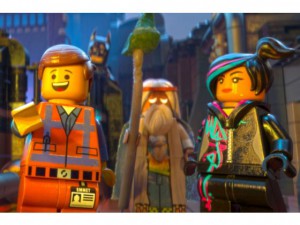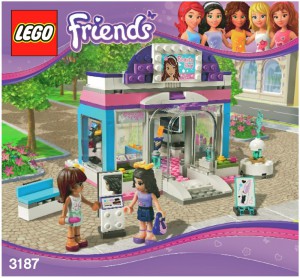Following the Instructions
 Much of the commentary surrounding The LEGO Movie recognized the contradiction between narrative critique of conformity to social “instructions” and promotion of mass-produced, build-by-instruction toys. The most astute recognized how the film’s many narrative pleasures nevertheless celebrated a particularly white, masculinized creative individualism. Sure, most of the LEGO minifigure characters have the same yellow skin-color; still, the noticeably darker Vetruvius (voiced by Morgan Freeman) plays the “magical negro” whose spiritual wisdom empowers normative protagonist Emmet as “the special.” Female characters like Wyldstyle too see their strength operate in support of the mundane, but ultimately more special, creative power of the male hero. While I only rehearse these particular arguments a month later, I do think they provide an excellent platform for continuing to think about LEGO, the idea of “creativity,” and the unequal extension of that idea to different consumer groups.
Much of the commentary surrounding The LEGO Movie recognized the contradiction between narrative critique of conformity to social “instructions” and promotion of mass-produced, build-by-instruction toys. The most astute recognized how the film’s many narrative pleasures nevertheless celebrated a particularly white, masculinized creative individualism. Sure, most of the LEGO minifigure characters have the same yellow skin-color; still, the noticeably darker Vetruvius (voiced by Morgan Freeman) plays the “magical negro” whose spiritual wisdom empowers normative protagonist Emmet as “the special.” Female characters like Wyldstyle too see their strength operate in support of the mundane, but ultimately more special, creative power of the male hero. While I only rehearse these particular arguments a month later, I do think they provide an excellent platform for continuing to think about LEGO, the idea of “creativity,” and the unequal extension of that idea to different consumer groups.
 Claims about “creativity” anchor LEGO marketing strategies and the meanings ascribed to LEGO products. The company pledges parent- and educator-friendly engagement “in the development of children’s creativity through play and learning.” Countless press releases tout this support of creativity; even the embrace of media licenses like Star Wars was framed as a boon to (rather than limit upon) creative imagination. The ideological frame of creativity also underpinned LEGO’s most recent gender-differentiated appeals to girl builders. While the 2012 LEGO Friends theme commendably corrected the exclusive focus on boys, would-be inclusiveness manifested predictably as market segregation. Girls and boys were not imagined as playing together, but instead as two classes of builders with different creative desires and needs. Girls, according to LEGO, needed more role-playing and even different kinds of human representations (“minidolls” instead of minifigures). Notions of inherent creative difference legitimated narrowly gendered marketing appeals.
Claims about “creativity” anchor LEGO marketing strategies and the meanings ascribed to LEGO products. The company pledges parent- and educator-friendly engagement “in the development of children’s creativity through play and learning.” Countless press releases tout this support of creativity; even the embrace of media licenses like Star Wars was framed as a boon to (rather than limit upon) creative imagination. The ideological frame of creativity also underpinned LEGO’s most recent gender-differentiated appeals to girl builders. While the 2012 LEGO Friends theme commendably corrected the exclusive focus on boys, would-be inclusiveness manifested predictably as market segregation. Girls and boys were not imagined as playing together, but instead as two classes of builders with different creative desires and needs. Girls, according to LEGO, needed more role-playing and even different kinds of human representations (“minidolls” instead of minifigures). Notions of inherent creative difference legitimated narrowly gendered marketing appeals.
 Defenders of Friends nevertheless pitched the modular creativity of LEGO as a get-out-of-gender-free card. Kids “don’t have to follow” the included instructions, this thinking went. Gender normative bakeries and beauty salons could become pink and purple starfighters. Though packaging and instructions offer what Ellen van Oost and Mary Kearney term “gender scripts,” the reconfigurable nature of LEGO product promised such scripts could also be “backdoors,” enticing already gendered subjects to creative experimentation. The ideological utility of creativity for LEGO came in both demanding gender conformity and offering ways out of it.
Defenders of Friends nevertheless pitched the modular creativity of LEGO as a get-out-of-gender-free card. Kids “don’t have to follow” the included instructions, this thinking went. Gender normative bakeries and beauty salons could become pink and purple starfighters. Though packaging and instructions offer what Ellen van Oost and Mary Kearney term “gender scripts,” the reconfigurable nature of LEGO product promised such scripts could also be “backdoors,” enticing already gendered subjects to creative experimentation. The ideological utility of creativity for LEGO came in both demanding gender conformity and offering ways out of it.
The LEGO Movie ruminates endlessly on this idea of following instructions. “Masterbuilders” like Vetruvius and Wyldstyle initially devalue Emmet’s interest in building and living by the instructions of mass culture. And yet, the film does not completely disarticulate creativity from such instructions. As Emmet takes on leadership, he explains the virtues of instructions as a platform for creative teamwork. And while the film culminates (spoiler alert) in a live-action meta-conflict over proper use of LEGO toys between an instruction-minded father and free-building son, the compromise reached suggests the father will continue building by instructions, just with newfound support for his son’s reconfiguration of them. The climactic action sequence in the animated world too turns on the idea of LEGO people rebuilding a prefabricated world, turning ice cream trucks into winged attack vehicles. In line with LEGO’s marketing of instruction-based building sets as “creative,” the film locates creativity somewhere beyond the instructions, but still figures those scripts as a key first step toward creativity. Meanwhile, the Ice Cream Machine can be sold in stores with instructions for building both on-screen configurations.
And despite the mélange of LEGO product in the film, including a visit to Cloud Cuckoo Palace that offers far more queer combinations of bricks than ever offered in prior instruction-based sets, the gender-specified creativity of LEGO Friends remains absent. The minidoll does not exist in this world. In the film’s concluding joke, meanwhile, the live-action father insists that a toddler sister join in the family play—a moment some take to task for suggesting that girls would disrupt the masculine creativity being celebrated. But that critique may give LEGO too much credit. As imagined by LEGO marketing, this toddler would be a user of larger DUPLO bricks, a product LEGO is still willing to market (in part) via gender-neutral appeals, in significant contrast to gendered segregation for older markets. The LEGO Movie does not acknowledge the possibility of girls aged four-and-up (or mothers) sharing in this creative LEGO play, more easily recognizing the creative commonality of privileged male consumers with DUPLO toddlers than with feminized Friends builders. Rather than entertaining disruption of LEGO’s creative ideologies, this narrative extension of LEGO play to a less fully gendered toddler market affirms their boundaries.
Ultimately, this film helps positions creativity as something that unfolds in relation, but not strict opposition, to clearly defined scripts (gendered or otherwise). Obviously, that serves the instruction-based product LEGO markets, but it also has implications for how we understand the “creativity” of those who make use of it.




Great post, Derek! (I loved the Lego movie, but the white masculinity and individualism immediately stuck out to me too.)
You note that these arguments (about male heroes, “magical negros,” the mundane, normativity, etc.) provide an “excellent platform for continuing to think about LEGO, the idea of ‘creativity,’ and the unequal extension of that idea to different consumer groups.”Agreed! I just wanted to throw one more keyword out there that I think is useful (and under-utilized in media studies), which doesn’t come up in your post. You talk about creativity, modularity, building, play… but you don’t mention design. The trusty wikipedia entry for design begins: “Design is the creation of a plan or convention for the construction of an object or a system.” And this is the distinction I saw at work in the Lego movie: there is a big difference between “following instructions” and “having a plan.” http://en.wikipedia.org/wiki/Design
I’ve been thinking about this a lot lately in terms of bridging the fields of STS, media and communication studies (great new collection by Gillespie, Boczkowski, and Foot, btw: “Media Technologies: Essays on Communication, Materiality, and Society”) http://www.amazon.com/Media-Technologies-Communication-Materiality-Technology/dp/0262525372
You and Jonathan have a wonderful collection on media authorship. This seems to be the favored term to talk about media creation. Design doesn’t come up often come up in media studies. I just wanted to urge more of us to consider this a little more deeply (Shameless plug: I’m presenting on similar themes at SCMS in Seattle, SAT 5PM w/ 3 other great presenters– Michael Newman, William Boddy, and Andrew Bottomley– come! Session Q8, Room8)
Design offers “scripts” (like gender) too; it’s never “ideologically neutral” even if mid-century modernists once claimed that certain typefaces (Helvetica!) could be.
Anyway, great post and I look forward to seeing you in Seattle.
P.S. You don’t exactly apologize for bringing these arguments to the table a month later (thankfully!) but as I said in a comment to Germaine’s post that I made 3 weeks after the fact (/2014/02/24/a-look-back-at-what-exactly/comment-page-1/#comment-428998), I want to claim a slow food movement for the internet. I called it “slow news” in that comment, but I’ve got a better term: slow feed. Nothing wrong with taking time to pause and reflect instead of racing to be first!
Thanks, Megan! I really enjoyed the movie too, as much as this post might suggest otherwise. But that doesn’t mean we can’t be ambivalent about its pleasures.
I’d love to hear more about this distinction between following instructions and having a plan, as you’re right that design deserves more attention here. At a production level, LEGO calls the folks it employs to come up with ideas for playsets “LEGO Designers,” and in their promotional videos and such, that term seems to carry capital beyond a simple job title. I’m curious though where you see the design of an object or system ending. It clearly seems like design to come up with the system of interlocking bricks and the function of LEGO bricks to be reconfigurable in different ways (ie, designing the LEGO system). Is it also “design” to develop a singular plan for how LEGO bricks could be made into a Batmobile object? Ultimately, I think what I’m asking is whether there is a big difference between construction of an “object” or construction of a “system”–and maybe media studies’ emphasis on authorship has been because of an emphasis on texts as the former.
Though to call out one place where we do talk about design in media studies (and a topic featured in our collection) is production design, and more broadly the design of worlds in which stories can unfold. I think this is a potential productive link between film studies and digital media studies.
And as much as this point might suggest otherwise, I’m not trying to decry LEGO’s embrace of instructions compared to the mythical “basic bucket of bricks” we all seem to remember from our childhood. I love being shown how to build Batmobiles and the like, and I think that there is something to be said about learning building techniques that you can apply elsewhere by following the instructions LEGO provides. But it’s where those scripts intersect with gender scripts that I start getting worried.
Thanks!
Derek, that’s really interesting that LEGO playset makers are “Designers” and I think you’re right that there is a particular kind of work here that, as you say, carries capital beyond a simple job title. Good question about where the design of an object or system ends. I’m currently reading Appadurai’s The Future as Cultural Fact and he has a chapter on “The Social Life of Design.” In some ways it is a continuation of the Social Life of Things. But I find it interesting because he makes some big claims about design.
I’m talking a little more about this stuff tomorrow at SCMS, but one thing I found provocative about Appadurai’s work is his claim that design is one of the primary forces of social order. He argues that we can’t talk about any object as simply a thing. (A tree might be a thing, but a tree brought into the orbit of social life– trees cut, painted, pruned– becomes a designed thing.) What’s more, he claims that ordinary humans are designers of social forms that define and reproduce the everyday (ie, it is by design that we choose how to spend our energies, we design our time and our day, always against constraints, but we engage every day in deploying our resources, ideas, bodies in order to accomplish goals and to aspire.) “Professional design” (i.e., LEGO designers, web designers, interior designers) takes place against this social ground and becomes connected to markets, money, and merchandising. And, as you point out, gender scripts come into play in the process.
Anyway, whoa. There’s a lot here that I haven’t worked out, but like I said, I find it provocative and think it could be of use in media studies… perhaps even beyond production design. My interest comes from looking for alternatives to STS concepts like actor network theory, which is useful but not as media and cultural studies friendly as it could be.